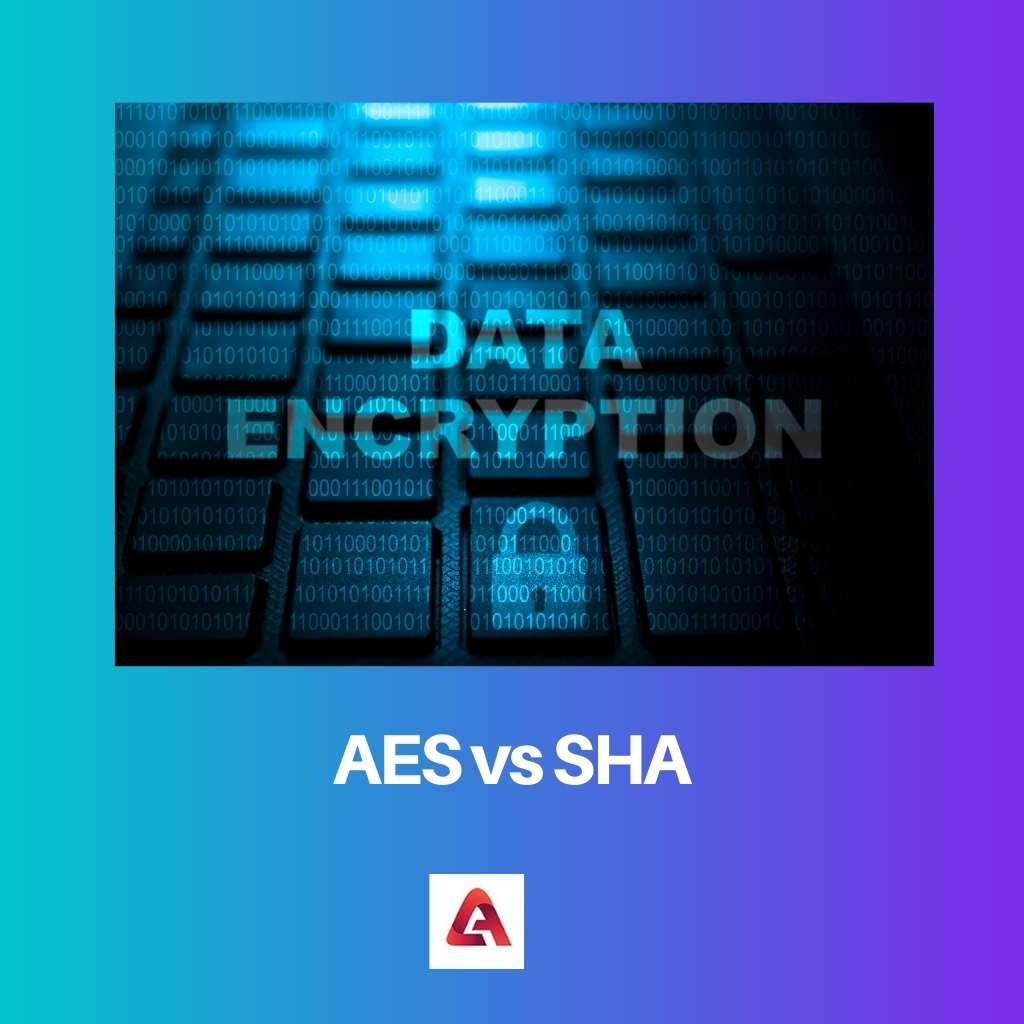AES stands for Advanced Encryption Standard whilst SHA stands for Secure Hash Algorithm. AES hand is a cipher that’s used to encrypt. SHA however is a set of hashing algorithms.
Another important point is that AES is digital content confidentiality protected via data scrambling whereas SHA is digital data one-way hashing.
Key Takeaways
- AES (Advanced Encryption Standard) is a symmetric encryption algorithm used for data encryption, while SHA (Secure Hash Algorithm) is a cryptographic hash function designed for data integrity and authentication.
- AES provides confidentiality by encrypting and decrypting data using a secret key. At the same time, SHA generates a fixed-size hash value from input data, which can be used to verify data integrity.
- AES is faster and more efficient for encrypting large amounts of data, while SHA is best suited for securing smaller pieces of information and ensuring data hasn’t been tampered with.
AES vs SHA
AES is a symmetric encryption algorithm used for securing any data. It is used to encrypt and decrypt data using a shared secret key. SHA is a family of cryptographic hash functions that ensure data integrity and authenticity. It takes data of any length and gives fixed-length output.

AES or Advanced Encryption Standard is a specification used in the encryption of cyber information hooked up through the U.S NIST or National Institute of Standards and Technology in 2001.
AES is extensively used nowadays as it’s far, far more potent than triple-DES and DES no matter being more difficult to implement.
The SHA (Secure Hash Algorithm) Family designates a circle of relatives of six specific hash functions. They take variable periods to enter messages and hash them to fixed-period outputs. …
Next, the message is processed block with the aid of using the underlying compression function.
Comparison Table
| Parameters of Comparison | AES | SHA |
|---|---|---|
| Objective | It is used to transmit data securely. | It is used to verify data. |
| Uses | For transferring sensitive business information, etc. | For sending passwords, files, and for searching. |
| Result | The original message can be retrieved using the decryption key. | The original message cannot be retrieved. |
| Nature | It is reversible and bi-directional. | It is irreversible and unidirectional. |
| Security | Less secure. | More secure. |
What is AES?
The Advanced Encryption Standard (AES) is a symmetric block cipher chosen by the United States government to protect labeled data. To encrypt sensitive records, AES is used in software and hardware all over the globe.
It is critical for government computer security, cybersecurity, and the protection of virtual data.
The National Institute of Standards and Technology (NIST) commenced improvement of AES in 1997 The National Institute of Standards and Technology (NIST) began developing AES in 1997, after seeing the need for an
alternative to the Data Encryption Standard (DES), which was becoming vulnerable to brute-force attacks. AES is made up of three block ciphers.
Each cipher encrypts and decrypts data in 128-bit blocks. The use of 128, 192, and 256-bit cryptographic keys, respectively.
Ciphers that are symmetric, known as the name of the game key, encrypt and decode using the same key.
The thriller key must be known and used by both the sender and the receiver. Information is classified by the government into three categories: confidential, secret, and top secret.
The Confidential and Secret levels can be protected with any key length. Both 256-bit and 192-bit key lengths are required for Top Secret information.
The AES encryption set of rules specifies the number of alterations that must be made to data stored in an array.
What is SHA?
SHA is the acronym for Secure Hash Algorithm, used for hashing records and certificates files. Every piece of record produces a unique hash that is very well non-duplicable through some other piece of record.
The ensuing virtual signature is specific too because it relies upon the hash that’s generated out of the records.
For the direction of real communication, symmetric cryptography is used, in which the identical key that hashes or encrypts records is used to decrypt it.
SHA is the cryptographic set of rules followed through the PKI marketplace for virtual signatures.
SHA-1 and SHA-2 are variations of this set of rules. The distinction among those variations lies in the “length” or the “range of bits” that the hashed output (known as a message digest) includes for a given plaintext input.
SHA works in the sort of manner even though a single character of the message is modified, then it’ll generate a unique hash.
By referencing the unique hash digest, a person can inform if even a single letter has been modified, because the hash digests can be unique. One of the essential elements of SHAs is that they’re deterministic.
This way that so long as the hash characteristic used is known, any pc or person can recreate the hash digest.
Main Differences Between AES and SHA
- AES is symmetric cryptography meaning it uses the same key for encryption and decryption while SHA is a hash means one way of encryption. So that it gives no way for decryption.
- AES is digital content confidentiality protected via data scrambling whereas SHA is digital data one-way hashing.
- AES can encrypt streams of statistics pretty quickly, however, best if the (symmetric) key has been formally agreed while SHA (Secure Hash Algorithms), is evolved via the means of the National Security Agency.
- AES has three types of encryption while SHA has six types of hashing.
- an entry to be applied, at the same time as AES calls for as a minimum three things: what you are encrypting/decrypting, an encryption key, and the initialization vector (IV). whereas SHA does not require it,


